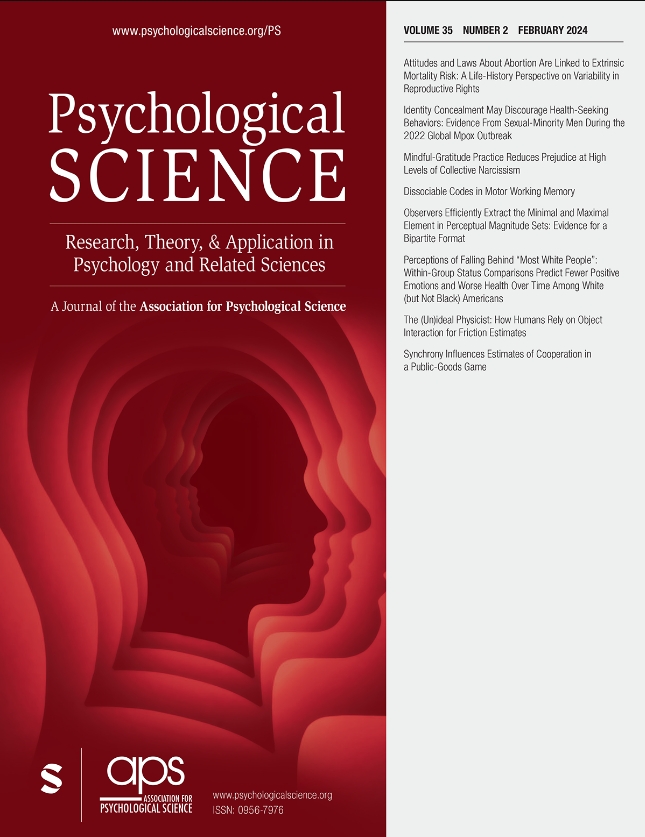运动失声幻觉取决于以物体为中心的表象
IF 4.8
1区 心理学
Q1 PSYCHOLOGY, MULTIDISCIPLINARY
引用次数: 0
摘要
运动静默是一种令人震惊且无法解释的视觉错觉,当变化的元素也在运动时,原本显著的变化就变得难以察觉。我们开发了一种量化错觉强度的新方法(实验 1a 和 1b),并证明了与缺乏旋转的高度受控刺激相比,旋转运动对错觉强度的优先作用(实验 2a 至 3b)。这些对比使得我们难以用较低的检测极限来解释这种错觉。相反,我们将错觉解释为未能将变化归因于位置。旋转会加剧这种错觉,因为它的感知依赖于结构化的物体表征。这就要求位置既要相对于物体内部框架,又要相对于外部框架,从而增加了归因变化的难度。最后的两个实验(4a 和 4b)采用了同步旋转的外部参照系,削弱了原本强烈的运动静默现象,从而为这一解释提供了支持。所有参与者都是约翰霍普金斯大学的本科生。本文章由计算机程序翻译,如有差异,请以英文原文为准。
The Motion-Silencing Illusion Depends on Object-Centered Representation
Motion silencing is a striking and unexplained visual illusion wherein changes that are otherwise salient become difficult to perceive when the changing elements also move. We develop a new method for quantifying illusion strength (Experiments 1a and 1b), and we demonstrate a privileged role for rotational motion on illusion strength compared with highly controlled stimuli that lack rotation (Experiments 2a to 3b). These contrasts make it difficult to explain the illusion in terms of lower-level detection limits. Instead, we explain the illusion as a failure to attribute changes to locations. Rotation exacerbates the illusion because its perception relies upon structured object representations. This aggravates the difficulty of attributing changes by demanding that locations are referenced relative to both an object-internal frame and an external frame. Two final experiments (4a and 4b) add support to this account by employing a synchronously rotating external frame of reference that diminishes otherwise strong motion silencing. All participants were Johns Hopkins University undergraduates.
求助全文
通过发布文献求助,成功后即可免费获取论文全文。
去求助
来源期刊

Psychological Science
PSYCHOLOGY, MULTIDISCIPLINARY-
CiteScore
13.30
自引率
0.00%
发文量
156
期刊介绍:
Psychological Science, the flagship journal of The Association for Psychological Science (previously the American Psychological Society), is a leading publication in the field with a citation ranking/impact factor among the top ten worldwide. It publishes authoritative articles covering various domains of psychological science, including brain and behavior, clinical science, cognition, learning and memory, social psychology, and developmental psychology. In addition to full-length articles, the journal features summaries of new research developments and discussions on psychological issues in government and public affairs. "Psychological Science" is published twelve times annually.
 求助内容:
求助内容: 应助结果提醒方式:
应助结果提醒方式:


